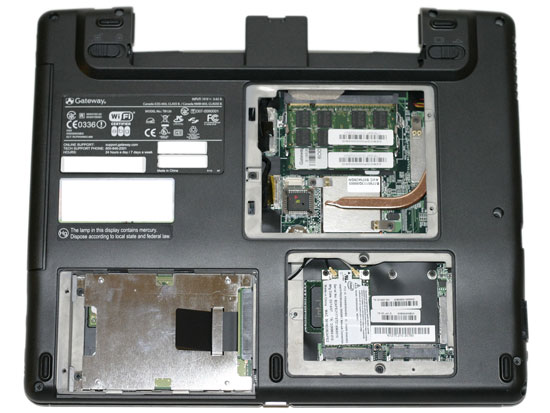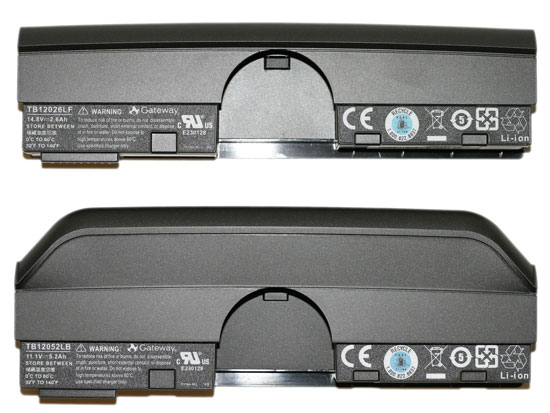Gateway E-155-C: A Lightweight Convertible
by Jarred Walton on July 4, 2007 12:05 AM EST- Posted in
- Laptops
Design and Appearance (Cont'd)
Looking at the bottom of the notebook, there are three compartments that can be accessed. At the top, the latch mechanism for the battery can also be seen. The left latch can be used to lock the battery in place to prevent accidental removal, while the right latch is spring-loaded and needs to be pushed aside in order to hold the battery out. The batteries also have a power gauge that can be seen here, which will allow you to see an estimate of how much battery life remains without connecting the battery or turning on the laptop.
Removing the three covers, we gain access to the hard drive, memory, and two Mini PCI slots. Starting with the latter, the left Mini PCI slot is occupied by the wireless adapter while the other is empty in our laptop and could be used for further expansion. The DDR2 SO-DIMM slots are in the top section, and you can also see part of the heatsink/heatpipe that is used to cool the CPU and chipset. If you actually want to swap processors, you will need to remove the rest of the bottom cover in order to access the CPU socket. The hard drive is in the bottom left compartment, and it's worth pointing out that Gateway uses an SATA hard drive.
Here's a look at the basic 4-cell as well as the upgraded 6-cell batteries. The smaller battery offers a 38.5 WHr capacity while the upgraded battery provides 57.7 WHr. That means that the increased capacity battery should offer about 50% more battery life, which as you'll see later is pretty much exactly what we measured.
Looking at the design as a whole, there's really a lot to like. The battery configuration works well, whether you stick with the default 4-cell or opt for one with increased capacity. All of the necessary connections are present and accounted for, with one exception: there's a VGA port, but no DVI port. We'd prefer to ditch the VGA support in preference for a digital connection, as the vast majority of people - particularly those considering an expensive ultraportable laptop - will have LCDs. However, businesses that use projectors are more likely to want a VGA port, which accounts for the design decision. (We'd still prefer a DVI port with a DVI-to-VGA adapter instead, though!) Given the size of the laptop, it's not too surprising that there aren't a lot of extra connections available. Two USB ports? A keyboard and mouse will take care of those! If you're like us, investing in a USB hub for when your laptop is sitting at a desk might be a good idea. Some people will always want more, and that's not the purpose of the thin and light laptops. As such a design, the E-155-C has everything we need and really doesn't have any major flaws, especially for business users.
 |
Looking at the bottom of the notebook, there are three compartments that can be accessed. At the top, the latch mechanism for the battery can also be seen. The left latch can be used to lock the battery in place to prevent accidental removal, while the right latch is spring-loaded and needs to be pushed aside in order to hold the battery out. The batteries also have a power gauge that can be seen here, which will allow you to see an estimate of how much battery life remains without connecting the battery or turning on the laptop.
 |
Removing the three covers, we gain access to the hard drive, memory, and two Mini PCI slots. Starting with the latter, the left Mini PCI slot is occupied by the wireless adapter while the other is empty in our laptop and could be used for further expansion. The DDR2 SO-DIMM slots are in the top section, and you can also see part of the heatsink/heatpipe that is used to cool the CPU and chipset. If you actually want to swap processors, you will need to remove the rest of the bottom cover in order to access the CPU socket. The hard drive is in the bottom left compartment, and it's worth pointing out that Gateway uses an SATA hard drive.
 |
Here's a look at the basic 4-cell as well as the upgraded 6-cell batteries. The smaller battery offers a 38.5 WHr capacity while the upgraded battery provides 57.7 WHr. That means that the increased capacity battery should offer about 50% more battery life, which as you'll see later is pretty much exactly what we measured.
Looking at the design as a whole, there's really a lot to like. The battery configuration works well, whether you stick with the default 4-cell or opt for one with increased capacity. All of the necessary connections are present and accounted for, with one exception: there's a VGA port, but no DVI port. We'd prefer to ditch the VGA support in preference for a digital connection, as the vast majority of people - particularly those considering an expensive ultraportable laptop - will have LCDs. However, businesses that use projectors are more likely to want a VGA port, which accounts for the design decision. (We'd still prefer a DVI port with a DVI-to-VGA adapter instead, though!) Given the size of the laptop, it's not too surprising that there aren't a lot of extra connections available. Two USB ports? A keyboard and mouse will take care of those! If you're like us, investing in a USB hub for when your laptop is sitting at a desk might be a good idea. Some people will always want more, and that's not the purpose of the thin and light laptops. As such a design, the E-155-C has everything we need and really doesn't have any major flaws, especially for business users.










25 Comments
View All Comments
elom - Wednesday, April 2, 2008 - link
This deal has been horrible for the companies that had existing warrenties with Gateway. MPC has still yet to get there act together and it is now April. My company has had 28 of these machines down since the begining of the year and only half have been fixed. I have NBD on-site service and I am not seeing anywhere close to that. I am moving to another PC manufacturer ASAP.tacoburrito - Wednesday, July 4, 2007 - link
With the 6 cell battery, this thing will weight over 5 lbs. Not really an ultra-portable in the classical sense, is it? But it seems this is what we have to put up with if one wants the Tablet features. Lenovo, Toshiba, and HP already have sub-3lbs notebooks in their catalouge running similar specs to the Gateway. Can you review those instead, if you want to do an ultra-portable review?JarredWalton - Wednesday, July 4, 2007 - link
As always, we review what we get sent. Needless to say, I'm not about to go out and spend $2000 on a notebook just to provide free press for a company. I've tried to get in touch with Lenovo, without much success. I'm working to get some stuff from Toshiba and HP that falls in the ultraportable range, so we'll see.Honestly, I'm not quite sure why the notebook is so heavy relative to others. The case does feel pretty durable, however, so that's probably a large part of the weight question. The display doesn't really feel much heavier than a normal laptop LCD - certainly not more than a few ounces. Anyway, lightweight and flimsy may not be the right way to go either - I'd probably take the extra pound if it means the display hinges and other parts don't break after a year or two.
bldckstark - Friday, July 6, 2007 - link
I'm disappointed to see that Lenovo hasn't responded to your requests. I would really like to see their V and X series ultraportables up against the competition.I bought my wife the Lenovo V series laptop that is almost an exact twin of the Gateway reviewed here, with the exception of the convertible screen. It is quicker than my desktop 3800+, weighs 4.4lbs with the 6 cell battery, and gets 255 mins runtime on, all for $1,250. It really puts the Gateway to shame. At least this time I didn't buy an expensive piece of electronics just to go online a month later to see a review of a cheaper, faster, better device that makes me want to throw up.
What I can't compare at home though is the LCD screen quality versus the Gateway. I would like to see if the Lenovo screens are better, worse, same. Especially on the V series versus the X/T series.
This makes me really want to see the Lenovo T60 reviewed to see how much dust the Gateway would be eating.
jonp - Friday, July 20, 2007 - link
I'd vote to add a Lenovo T61, p/n 7662 with the T7500 CPU, 2GB RAM, 7200rpm hard drive, XP Pro to a future review.Athlex - Wednesday, July 4, 2007 - link
Any chance of getting a photo of the keyboard and touchpad/trackpoint?Baffling that laptop manufacturers are putting "docking" ports on the sides of notebooks instead of the bottom. HPQ seems to be doing the same thing on their consumer stuff.
JarredWalton - Wednesday, July 4, 2007 - link
Sorry about that - I actually had the image on our server but forgot to update the first page before the article went live.I'm also a bit baffled about the docking port on the side... but then I don't see much reason for docking stations these days. All I really need is mouse, keyboard, and display - if I want more than that from a laptop, I'd probably get a nicer laptop rather than worrying about spending the money for a docking station.
strikeback03 - Thursday, July 5, 2007 - link
If you connect keyboard/mouse/monitor every day (or multiple times a day) it is probably convenient to only have to make one connection instead of 3. also, some docking stations offer ports the laptop does not - for example, most (if not all) thinkpad docking stations have DVI ports even though the laptop itself does not.One reason this might be heavier than other tablets is the included optical drive - lots of the ~3lb ones ditch that, and the whole case can shrink as a result.
JarredWalton - Thursday, July 5, 2007 - link
Gateway does list the laptop as weighing .3 lbs less with a "weight saver" - I'm guessing a plastic piece that fills the ODD slot. I do have to say that ditching the DVD - except you would have an external unit - isn't a good move IMO. That's just marketing trying to cut weight at all costs. I suppose I could live without a DVD in a pinch, but I really wouldn't want to.People that will spend $200+ to save themselves two connections are a bit out there, I'd say. The DVI port could be useful, but plenty of laptops have those anyway. Heck, ditch the docking port connector and give us DVI and we'd be set. Heh.
Verdant - Wednesday, July 4, 2007 - link
a lot of people seem to refer to the screens as "touch screens" i thought they used some sort of circuit that involved the stylus. Do tablets have a "touch" or "digitizer stylus" screen? Or do both exist?Personally i would prefer non-touch screen as writing on those can be difficult with my left-handedness.